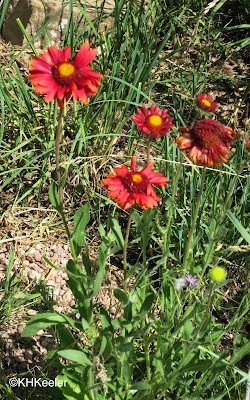Blanketflower, Gaillardia, is a native you probably know as a garden flower. Native garden flowers are not all that common.
Recently, talking and writing about garden flowers, I looked at the origins of common garden flowers and noticed that only a few of them are native to central North America. The simplest explanation is time. Europeans first encountered these American plants in the early 1800s, so that's the earliest that they might have been considered for European-style flower gardens. In contrast, many European and Asian plants have been grown in gardens for 2,000 years. The consequences of long periods in cultivation include familiarity--how often do we favor the plants we grew up with? In addition, cultivation changes plants to make them more attractive in gardens, creating multiple colors, multiple sizes (for example, dwarf varieties), doubled flowers, high and predictable seed germination, good survival of transplanted cuttings. It reduces undesirable characteristics such as spines and aggressive spreading. Roses, lilies, most iris, crocuses, peonies, dahlias, daffodils and narcissus, tulips, and lilacs--to name a few--are all from Eurasia.
I should add that to make bigger cells takes more material, so tetraploid hybrids often grow more slowly and require more water and nutrients than diploids, but rarely dramatically more.
It is a story of domestication, showing one pathway for developing garden plants native to central North America.
Comments and questions welcome.
Kathy Keeler
More at awanderingbotanist.com
Join me on Facebook: https://www.facebook.com/AWanderingBotanist
Buy the book! Curious Stories of Familiar Garden Plants by Kathy Keeler, A Wandering Botanist. This story and more! Now available at Amazon link
Join me on Facebook: https://www.facebook.com/AWanderingBotanist
Buy the book! Curious Stories of Familiar Garden Plants by Kathy Keeler, A Wandering Botanist. This story and more! Now available at Amazon link





No comments:
Post a Comment